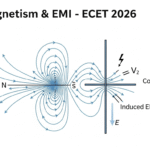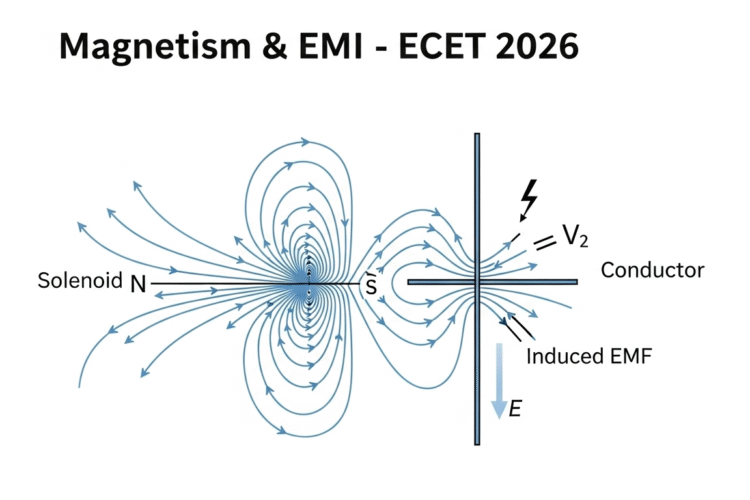
In ECET 2026, the Physics section often includes fundamental yet high-scoring concepts. One such topic is Heat & Temperature, which appears in both APECET and TSECET question papers. Understanding the difference between heat and temperature, along with related formulas, can help you quickly solve numerical and conceptual questions. Let’s revise this topic clearly with notes, followed by 10 targeted MCQs.
📘 Concept Notes – Heat & Temperature
🌡 Heat:
- Definition: Heat is a form of energy transferred between bodies due to a temperature difference.
- SI Unit: Joule (J)
- Common Unit: Calorie (1 cal = 4.186 J)
- Direction of flow: Always from a hotter body to a colder body until thermal equilibrium.
🌡 Temperature:
- Definition: A measure of the average kinetic energy of the particles in a substance.
- SI Unit: Kelvin (K)
- Other Units: Celsius (°C), Fahrenheit (°F)
- Conversion Formulas:
- K = °C + 273
- °F = (°C × 9/5) + 32
🔍 Key Differences:
| Feature | Heat | Temperature |
|---|---|---|
| Nature | Energy in transit | Measure of thermal state |
| SI Unit | Joule (J) | Kelvin (K) |
| Measured By | Calorimeter | Thermometer |
| Can be Stored? | No | Yes (in terms of thermal state) |
⚖ Specific Heat Capacity:
- Formula: Q = m × c × ΔT
Where:- Q = Heat absorbed/released (J)
- m = Mass (kg)
- c = Specific heat (J/kg·K)
- ΔT = Change in temperature (K or °C)
💡 Thermal Expansion:
- Solids expand when heated and contract when cooled.
- Coefficient of linear expansion (α) is used in calculations.
🔟 10 Most Expected MCQs – ECET 2026 [Heat & Temperature]
Q1. Heat is measured in:
A) Kelvin
B) Joule
C) Watt
D) Newton
Q2. Temperature is a measure of:
A) Total energy
B) Average kinetic energy
C) Potential energy
D) Heat capacity
Q3. Which instrument is used to measure heat?
A) Thermometer
B) Barometer
C) Calorimeter
D) Hygrometer
Q4. 0°C in Kelvin is:
A) 0 K
B) 100 K
C) 273 K
D) 373 K
Q5. Which of the following is NOT a unit of temperature?
A) Kelvin
B) Celsius
C) Joule
D) Fahrenheit
Q6. Heat flows from:
A) Cold to hot
B) Hot to cold
C) Both ways equally
D) None of these
Q7. If m = 2 kg, c = 4200 J/kg·K, ΔT = 10°C, then Q = ?
A) 8400 J
B) 42000 J
C) 84000 J
D) 4200 J
Q8. Which law explains heat transfer?
A) Newton’s First Law
B) Law of Conservation of Energy
C) Ohm’s Law
D) Boyle’s Law
Q9. The device used to measure temperature is:
A) Calorimeter
B) Thermometer
C) Voltmeter
D) Ammeter
Q10. 100°C is equal to how many Kelvin?
A) 100 K
B) 273 K
C) 373 K
D) 473 K
✅ Answer Key Table
| Q.No | Answer |
|---|---|
| Q1 | B |
| Q2 | B |
| Q3 | C |
| Q4 | C |
| Q5 | C |
| Q6 | B |
| Q7 | C |
| Q8 | B |
| Q9 | B |
| Q10 | C |
🧠 Explanations of All Answers
- Q1 → B: Heat is measured in Joules in SI units.
- Q2 → B: Temperature measures the average kinetic energy of particles.
- Q3 → C: Calorimeter is used to measure heat.
- Q4 → C: 0°C = 273 K.
- Q5 → C: Joule is a unit of energy, not temperature.
- Q6 → B: Heat naturally flows from hot to cold objects.
- Q7 → C: Q = 2 × 4200 × 10 = 84,000 J.
- Q8 → B: Heat transfer follows the Law of Conservation of Energy.
- Q9 → B: Thermometer is used to measure temperature.
- Q10 → C: 100°C + 273 = 373 K.
🎯 Why This Practice Matters for ECET 2026
Heat & Temperature is a straightforward Physics topic where conceptual clarity can guarantee full marks. With repeated patterns in past ECET papers, practicing MCQs and numerical applications ensures accuracy and quick solving speed during the exam.
📲 Join Our ECET Prep Community on Telegram
Get Physics notes, MCQs, and mock tests directly on your phone.
👉 @LearnNewThingsHub



